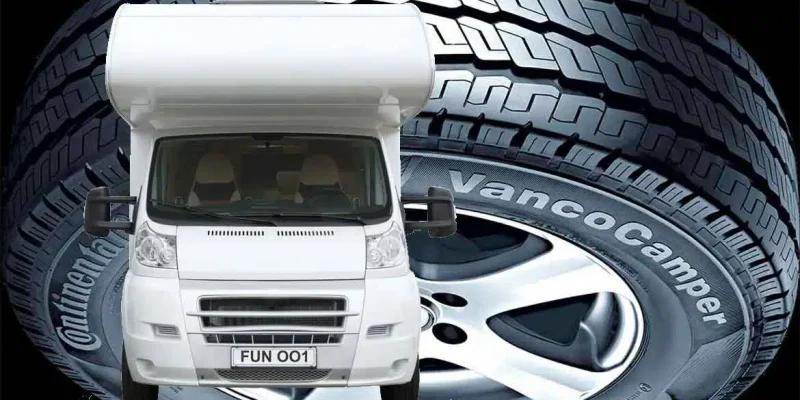Motorhome Tyres 101: How to Choose the Best for Your RV

Choosing the right tyres for your motorhome is crucial for ensuring a safe, comfortable, and efficient journey. With the myriad of options available, making an informed decision can be overwhelming. This comprehensive guide will walk you through everything you need to know about selecting the best motorhome tyres, covering key factors like size, load capacity, tread pattern, and more.
Understanding the Importance of Motorhome Tyres
Motorhome tyres are not just regular vehicle tyres; they are specifically designed to handle the weight and unique dynamics of a motorhome. Proper tyre selection and maintenance are essential for safety, fuel efficiency, and overall driving comfort. The right tyres can significantly reduce the risk of blowouts, improve handling, and enhance your overall travel experience.
Motorhome Tyres: Determining the Correct Tyre Size
Selecting the correct tyre size is one of the most critical factors when choosing motorhome tyres. The size is usually indicated on the sidewall of your current tyres and is expressed in a series of numbers and letters (e.g., 225/75R16). Understanding what these numbers mean is essential:
- 225: The width of the tyre in millimetres.
- 75: The aspect ratio, indicating the height of the sidewall as a percentage of the width.
- R: Indicates radial construction, which is standard for most tyres.
- 16: The diameter of the wheel in inches.
Using tyres that are the correct size for your motorhome ensures optimal performance and safety.
Load Rating: Ensuring Your Tyres Can Handle the Weight
Motorhomes are heavy vehicles, especially when fully loaded with passengers, gear, and supplies. The load rating of a tyre indicates the maximum weight it can safely carry. It’s essential to choose tyres with a load rating that exceeds the fully loaded weight of your motorhome. Overloading tyres can lead to excessive wear, increased risk of blowouts, and reduced handling performance.
Tread Pattern: Finding the Right Grip for Your Travels
The tread pattern of your tyres affects how well your motorhome grips the road under different conditions. There are various tread patterns to consider:
Highway Tread: Designed for smooth surfaces, providing a quiet and comfortable ride with excellent fuel efficiency.
- AllTerrain Tread: Offers a balance between on road comfort and offroad traction, ideal for motorhomes that occasionally venture off the beaten path.
- MudTerrain Tread: Best for motorhomes frequently driven on rugged, unpaved roads. These tyres provide superior traction in challenging conditions but may be noisier and less fuel efficient on highways.
Seasonal Considerations: AllSeason vs. Winter Tyres
Depending on where and when you plan to travel, you may need to consider seasonal tyres:
- AllSeason Tyres: Suitable for year round use in mild climates, offering good performance in both wet and dry conditions.
- Winter Tyres: Designed for cold temperatures and icy or snowy roads, providing better traction and safety in winter conditions. If you plan to travel in areas with harsh winters, investing in a set of winter tyres is advisable.
Tyre Construction: Radial vs. Bias Ply Tyres
Motorhome tyres come in two main types of construction:
- Radial Tyres: The most common type, radial tyres offer better fuel efficiency, a smoother ride, and longer tread life. They are ideal for long distance travel on highways.
- Bias Ply Tyres: These tyres have a more rigid sidewall, providing better durability and resistance to punctures. However, they may offer a less comfortable ride and reduced fuel efficiency compared to radial tyres. Bias ply tyres are often used on older motorhomes or those frequently driven on rough terrain.
Tyre Pressure: The Key to Safety and Efficiency
Maintaining the correct tyre pressure is vital for both safety and fuel efficiency. Underinflated tyres can lead to poor handling, increased fuel consumption, and a higher risk of blowouts. Overinflated tyres, on the other hand, can result in a harsh ride and uneven wear. Check your motorhome’s manufacturer recommendations for the correct tyre pressure and regularly inspect your tyres before and during trips.
Longevity and Wear: How to Make Your Tyres Last
Motorhome tyres, when properly maintained, can last for several years. Here are some tips to extend the life of your tyres:
- Regular Inspections: Check your tyres for signs of wear, such as cracks, bulges, or uneven tread wear.
- Proper Storage: If your motorhome is stored for long periods, ensure the tyres are protected from direct sunlight and harsh weather conditions. Using tyre covers can help.
- Rotation: Regularly rotate your tyres to ensure even wear.
- Avoid Overloading: Stick to the recommended load limits to prevent excessive strain on your tyres.
Balancing Cost and Quality: How to Choose the Best Value
When it comes to motorhome tyres, balancing cost and quality is essential. While it may be tempting to opt for cheaper tyres, investing in high quality tyres from reputable brands is a better long term investment. High Quality tyres provide better safety, durability, and fuel efficiency, which can save you money in the long run.
Buying and Replacing Tyres: What to Look For
When it’s time to buy or replace your motorhome tyres, consider the following:
- Brand Reputation: Choose tyres from well known, reputable brands that are known for their quality and reliability.
- Warranty: Look for tyres that come with a warranty, which can provide peace of mind and protection against defects.
- Professional Installation: Have your tyres professionally installed and balanced to ensure optimal performance and safety.
- Replacement Frequency: Even if your tyres appear in good condition, they should be replaced every 57 years due to the natural aging of the rubber.
Conclusion
Choosing the right tyres for your motorhome is a crucial decision that affects your safety, comfort, and overall travel experience. By understanding the factors such as size, load rating, tread pattern, and tyre construction, you can make an informed choice that meets your specific needs. Regular maintenance and proper care will ensure your tyres last longer, providing you with a smooth and safe journey wherever your adventures take you.
FAQs
1. How often should I check my motorhome tyre pressure?
It’s recommended to check your motorhome tyre pressure at least once a month and before every trip. Tyre pressure can fluctuate with temperature changes, so regular checks ensure your tyres are always at the optimal pressure for safe and efficient driving.
2. Can I mix different tyre brands or types on my motorhome?
Mixing different tyre brands or types is generally not recommended. It can lead to uneven wear and affect handling, especially in emergency situations. For the best performance and safety, use the same brand, size, and type of tyres on all wheels.
3. What should I do if I notice uneven wear on my motorhome tyres?
Uneven wear can be a sign of improper tyre pressure, misalignment, or worn suspension components. If you notice uneven wear, have your tyres and motorhome checked by a professional to address the underlying issue before it leads to more serious problems.
4. How do I know when it’s time to replace my motorhome tyres?
Motorhome tyres should be replaced when the tread depth falls below 3mm, when they show signs of significant wear (e.g., cracks, bulges), or when they are 57 years old, regardless of tread condition. Regular inspections will help you identify when replacement is necessary.
5. Are there specific tyres for different motorhome models?
Yes, different motorhome models may require specific tyre sizes and load ratings. Always consult your motorhome’s owner’s manual or a professional to ensure you choose the correct tyres for your specific model.
Also read: Gilford Castle: 10 Fascinating Facts That Will Blow Your Mind











